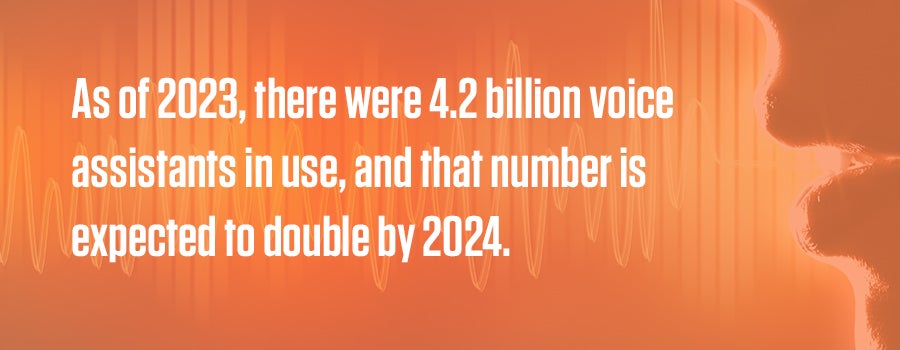In 1962, IBM created the first voice recognition device. The then-revolutionary Shoebox could understand 16 total words and digits and even process commands and run programs based on that was asked. It would take another five decades to go from Shoebox to Siri, and a few more years after that to reach a point in time where AI-powered voice assistants are practically commonplace.

Now, more than half of adults say they use voice search every day, which means it’s up to content creators and business owners to shape content in a way that AI and voice search assistants can easily scan, understand and utilize.
What Is Voice Search Optimization?
If you’ve ever asked Siri or Alexa to look up the local weather forecast or tell you how many teaspoons are in a quarter cup while you’re elbow deep in pancake batter, you’ve used voice search. Until recently, however, voice searches were a bit of a one-way street. The artificial intelligence behind search results simply scrolled the internet as best it could, given whatever speech patterns the asker used.
Voice search optimization seeks to streamline and improve the process, putting more power in the hands of content creators and businesses eager to rank. By reviewing your website’s content, including things such as structure and keyword usage, you can ensure the text assets you post align with natural language search queries and the more conversational language patterns used in questions that are vocalized rather than typed.

How to Incorporate AI and VSO in Your SEO Efforts
Here’s how you can leverage AI and voice search optimization to help improve your SEO and overall ranking.
- Write conversationally. Prioritize natural language and a conversational tone that reflect how people talk when conducting voice-based searches.
- Target question-centric keywords. Long-tail keywords in the form of a question are more common in voice search queries. Think “How do I repair a leaky faucet?” instead of just “leaky faucet problems” and “Where can I find the nutritional content in Bob’s burgers?” over “Bob’s burgers calories.” This aligns with Google’s BERT update, which was created specifically to decode the correct meaning of search queries and consider long-tail search terms.
- Include FAQ sections. Writing as if you’re answering a question can help optimize content for voice-based searches, but creating a FAQ section takes that concept even further.
- Try to nab the featured snippet spot. Voice assistants are more likely to pull answers from featured snippets (those boxed-in answers featured at the top of search result pages) than from lower-ranked sites. By providing high-quality, highly accurate and well-written information, you’re better positioned to become the featured snippet and boost site visibility.
- Claim your GBP profile. Google trolls Google Business Profile listings for information related to specific organizations, including addresses, hours of operation and phone numbers. Claim your listing and update the info, and you’re more likely to be featured in voice searches related to your area and industry.
- Optimize for local SEO (when relevant). If your business can benefit from appealing to a local audience, incorporate content that would speak to location-based voice search queries. For example, your Italian restaurant might pepper its website with phrases such as “antipasto salad in Burbank” and “Italian food delivery in 91501.”
- Pay attention to structured data. Technical SEO will always be important, and now that includes implementing structured data, too. This refers to the HTML markup you can use to help Google understand and display your content the way you intended. Updating your schema can help pave the way for becoming a featured snippet and appearing high up in voice search results.
As of 2023, there were 4.2 billion voice assistants in use, and that number is expected to double by 2024. By creating content with voice search in mind today, your business can be better prepared to soar to the top of the SERPs tomorrow, increasing visibility, click-through rates and brand recognition in one fell swoop.